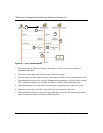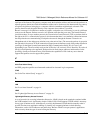
7000 Series L3 Managed Switch Reference Manual for Software v2.0
C-6 Glossary
and checks to make sure the accompanying numerical value is the same. If not, the receiver can assume that
the message has been corrupted.
Class of Service
A term to describe treating different types of traffic with different levels of service priority. Higher priority
traffic gets faster treatment during times of switch congestion
CLI
See “Command Line Interface” on page 6.
Collision
A term used to describe two colliding packets in an Ethernet network. Collisions are a part of normal
Ethernet operation, but a sudden prolonged increase in the number of collisions can indicate a problem with
a device, particularly if it is not accompanied by a general increase in traffic.
Command Line Interface
CLI is a line-item interface for configuring systems.
Common Open Policy Service Protocol.
A proposed standard protocol for exchanging network policy information between a Policy Decision Point
(PDP) in a network and Policy Enforcement Points (PEPs) as part of overall Quality of Service (QoS) - the
allocation of network traffic resources according to desired priorities of service. The policy decision point
might be a network server controlled directly by the network administrator who enters policy statements
about which kinds of traffic (voice, bulk data, video, teleconferencing, and so forth) should get the highest
priority. The policy enforcement points might be router or layer 3 switches that implement the policy
choices as traffic moves through the network. Currently, COPS is designed for use with the Resource
Reservation Protocol (RSVP), which lets you allocate traffic priorities in advance for temporary
high-bandwidth requirements (for example, video broadcasts or multicasts). It is possible that COPS will be
extended to be a general policy communications protocol.
Complex Programmable Logic Device.
CPLD is a programmable circuit on which a logic network can be programmed after its construction.
COPS
See “Common Open Policy Service Protocol.” on page 6.
CPLD
See “Complex Programmable Logic Device.” on page 6.


















